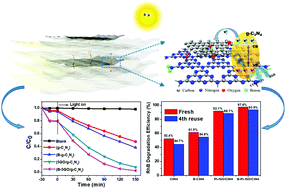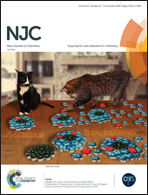Boosted visible light photodegradation activity of boron doped rGO/g-C3N4 nanocomposites: the role of C–O–C bonds†
Abstract
Heteroatom doping has been demonstrated to be an effective way to tune the properties of nanomaterials including chemical reactivity and electronic and optical performance. In this study, rGO/g-C3N4 and boron doped rGO/g-C3N4 (B-rGO/g-C3N4) nanocomposites were fabricated via a rapid plasma treatment method, and their photocatalytic performance under visible light radiation was examined. The results showed that the photocatalytic efficiency of B-rGO/g-C3N4 for rhodamine B degradation can be 50% higher than that of rGO/g-C3N4 at an optimum rGO loading of 5 wt%. XPS and FTIR analyses indicated the enhanced C–O–C covalent bonding between rGO and g-C3N4 in B-rGO/g-C3N4, and the optical characterization demonstrated that it could further improve the separation of the photo-generated chargers and narrow the bandgap of the nanocomposite. This work provides an idea that boron doping could be an effective way to promote the chemical interaction between different components in composite materials, which is important in designing and developing new functional nanomaterials.



 Please wait while we load your content...
Please wait while we load your content...